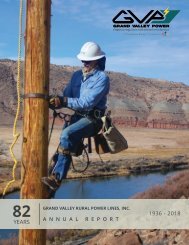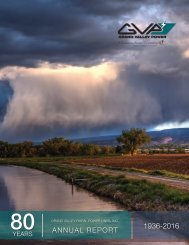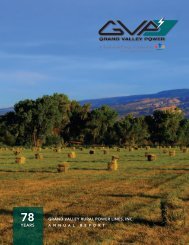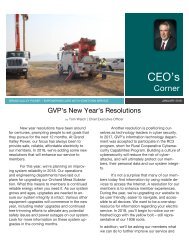2021 Annual Report: Celebrating 85 Years of Service
Flip through the pages of our 2021 Annual Report. This year, we're celebrating 85 years of dedicated service.
Flip through the pages of our 2021 Annual Report. This year, we're celebrating 85 years of dedicated service.
Create successful ePaper yourself
Turn your PDF publications into a flip-book with our unique Google optimized e-Paper software.
What is the cornerstone of our guiding principles?
Safety. In fact, it’s paramount to our business. In 2020,
we experienced what was the largest wildfire in Colorado
history. Now, in the aftermath, it’s still the third-largest
in the books having burned 139,007 acres of terrain. The
Pine Gulch Fire was started by a lightning strike on July 31,
2020, about 18 miles north of Grand Junction. Our local
agencies responded swiftly, but with the extreme drought
conditions, hot temperatures, high winds and treacherous
terrain, the fire soon became more difficult to control. Over
950 emergency responders and multiple agencies became
involved – all with concern for safety. The electric service
to approximately 89 members located in our De Beque service
area was disrupted on August 10, 2020, to ensure the
safety of the first responders and to support their firefighting
efforts. We worked closely with officials to determine
where and when to shut off power for public safety. The
efforts of our operations, engineering and communications
team members were critical to our success. Early on, there
were intense discussions on the worst-case scenario. Our
geographic information systems analyst and engineering
department were able to use mapping data supplied by the
incident team leaders to better display the structures and
co-op assets that were in the path of the fire. More than 300
poles were in the path of the fire, however, because of the
Incident Management Team’s responsiveness, Grand Valley
Power only had to replace four poles due to the fire.
Part of the communications with our affected
members included constant messaging on our Facebook
and Twitter social media channels. Communications also
included a mailed packet of information explaining restoration
efforts, and what to do once officials allowed people
back to their homes. In addition, we provided critical
information to the incident managers and sheriff’s office
representatives who relayed it onto community members.
GVP operations team members also went door-to-door
speaking with members not only about their power being
off, but to inspect the safety and health of the system and
meters before reenergizing a home. This is what makes the
cooperative difference. It’s Hometown Service.
Inspection, maintenance, and equipment upgrades
all play an important role in keeping our distribution system
secure, resilient, and reliable. It’s important to know
that your cooperative takes these critical components seriously.
Vegetation management is a part of this ongoing effort.
GVP is consistently looking at energized lines and their
proximity to trees or other vegetation. In 2020, 104 miles
of line had tree trimming and vegetation removed or maintained,
with over 3,000 total tree trims completed. Beyond
this, over 300 miles were visually inspected by our line patrolmen.
Some other engineering and operation highlights
included:
• Increased protective equipment and devices in
fire-sensitive areas to further increase resiliency and
safety.
• Grand Valley Power recorded a new system peak of
58.22 MW in early August.
• If outage minutes from the Pine Gulch Fire were excluded,
GVP’s System Average Interruption Duration
Index (SAIDI) would have been the lowest in our GVP
history.*
• Nearly 100 new distributed generation systems were
installed (private solar systems). GVP now has almost
600 total systems on our electric distribution grid.
• Continued system-wide infrastructure upgrades and
expansions, including transformers, lightning arrestors,
transformers and related equipment.
While natural disasters, a health pandemic and stay-at-home
orders affected the cooperative, we continue to see how staying
power means so much more. When we say, “we strive to do the right
thing, holding true to our values and principles,” we mean it. The
foundation we stand on is delivering safe, reliable, and affordable
electricity. During the extreme winter storm that blasted the central
United States, Grand Valley Power and its consumers were hit hard
financially due to Xcel Energy’s imposition of historically high fuel
cost adjustment charges for February 2021. The storm triggered a
tightening of the market for natural gas, which is relied upon by
energy providers like Xcel to heat homes and generate electricity.
The price of natural gas shot up to unprecedented high levels, often
hundreds of times greater than normal. What this meant to our residential
consumers was an average increase of $7.81 each month,
for the next 12 months, although some of our larger consumers saw
bills upwards of thousands of dollars. Grand Valley Power’s Power
Purchase Agreement with Public Service Company of Colorado (a
subsidiary of Xcel Energy) is regulated by the Federal Energy Regulatory
Commission (FERC) and is subject to that agency’s jurisdiction.
We are doing everything in our power to reduce the financial
impact that will be felt by all Grand Valley Power members. And so
our investigation and analysis will push forward.
Going forward, everyone on the Grand Valley Power team
understands that our members expect and deserve a reliable, affordable
source of electric energy. We will look closely at all options
available so that our results align with this expectation.
Pictured left: GVP Lineman Mike Birch (retired 2019) and Scott Bradley demonstrate
electrical safety around high-voltage powerlines back in the 1970’s. each
year grand valley power participates in numerous community-wide events to share
safety information related to overhead powerlines and padmount transformers.
* Including the pine gulch fire, members experienced an average of 103.7 minutes of
outage duration. Excluding the pine gulch, members experienced 49.433 minutes.
4 5
















